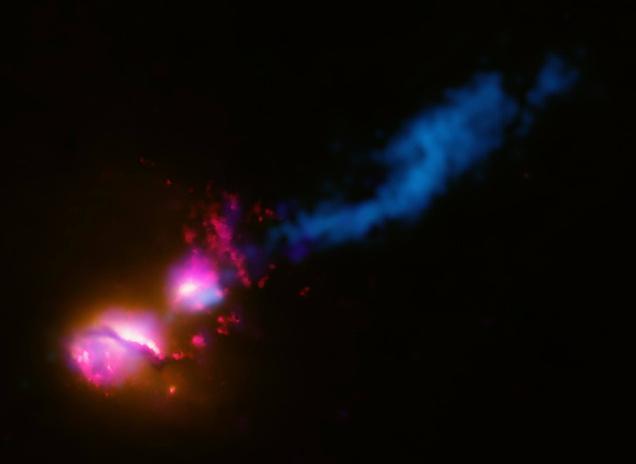April 23, 2014
Scientists have discovered the first pair of super-massive black holes in orbit around one another in a non-active galaxy.

April 23, 2014
Scientists have discovered the first pair of super-massive black holes in orbit around one another in a non-active galaxy.

Scientists have discovered the first pair of super-massive black holes in orbit around one another in a non-active galaxy. This file photo provided by NASA shows a powerful jet from a super massive black hole, blasting a nearby galaxy in the system known as 3C321.
The black holes were spotted by The European Space Agency’s X-ray Multi-Mirror Mission, XMM-Newton, because they ripped apart a star when the space observatory happened to be looking in their direction.
Two super-massive black holes are the smoking gun that the galaxy has merged with another.
Finding binary super-massive black holes can tell astronomers about how galaxies evolved into their present-day shapes and sizes, researchers said.
To date, only a few candidates for close binary super-massive black holes have been found. All are in active galaxies where they are constantly ripping gas clouds apart, in the prelude to crushing them out of existence.
The new discovery, by Fukun Liu, Peking University, Beijing, China, and colleagues, is important because it is the first to be found in a galaxy that is not active.
“There might be a whole population of quiescent galaxies that host binary black holes in their centres,” said co-author Stefanie Komossa, Max-Planck-Institut fur Radioastronomie, Bonn, Germany.
But finding them is a difficult task because in quiescent galaxies, there are no gas clouds feeding the black holes, and so the cores of these galaxies are truly dark.
On 10 June 2010, a tidal disruption event was spotted by XMM-Newton in galaxy SDSS J120136. The galaxy was still spilling X-rays into space.
The X-rays fell below detectable levels between days 27 and 48 after the discovery. Then they re-appeared and continued to follow a more expected fading rate, as if nothing had happened.
“This is exactly what you would expect from a pair of super-massive black holes orbiting one another,” said Liu.
Liu found that two possible configurations were possible to reproduce the observations of J120136.
In the first, the primary black hole contained 10 million solar masses and was orbited by a black hole of about a million solar masses in an elliptical orbit.
In the second solution, the primary black hole was about a million solar masses and in a circular orbit.
In both cases, the separation between the black holes was relatively small: 0.6 milliparsecs, or about two thousandths of a light year. This is about the width of our Solar System.
Being this close, the fate of this newly discovered black hole pair is sealed. They will radiate their orbital energy away, gradually spiraling together, until in about two million years time they will merge into a single black hole.
The finding was published in The Astrophysical Journal.
















































































































